From Continental Europe to England: the Anglo-Saxon migration during the Early Medieval Period. New insights from genetics
Archaeogenetic study reveals large-scale continental migration into the East of England during the early Medieval Period.
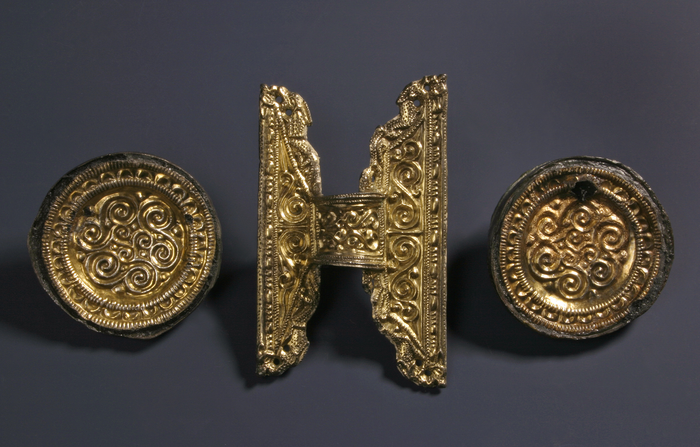
In the largest early-medieval population study to date, an interdisciplinary team consisting of geneticists and archaeologists – led by the Max Planck Institute for Evolutionary Anthropology and the University of Central Lancashire – analysed over 400 individuals from ancient Britain, Ireland, Germany, Denmark and the Netherlands. The results show in detail one of the largest population transformations in the post-Roman world.
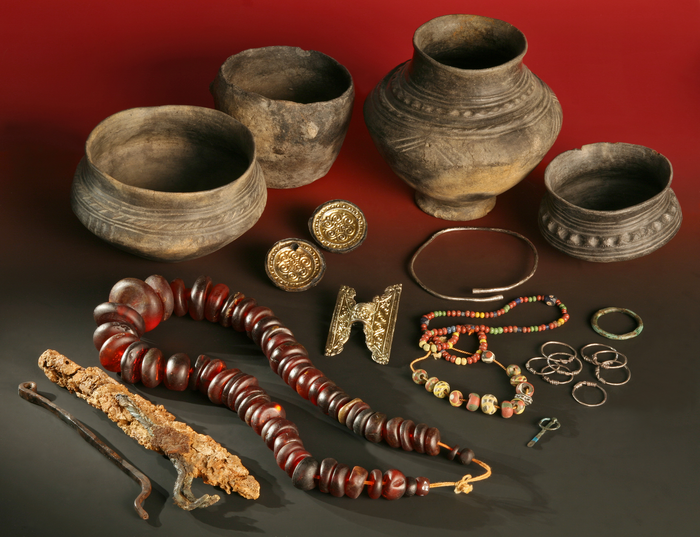
Around three hundred years after the Romans left, scholars like Bede wrote about the Angles and the Saxons and their migrations to the British Isles. Scholars of many disciplines, including archaeology, history, linguists and genetics, have debated what his words might have described, and what the scale, the nature and the impact of human migration were at that time.
New genetic results now show that around 75 percent of the population in Eastern and Southern England was made up of migrant families whose ancestors must have originated from continental regions bordering the North Sea, including the Netherlands, Germany and Denmark. What is more, these families interbred with the existing population of Britain, but importantly this integration varied from region to region and community to community.
“With 278 ancient genomes from England and hundreds more from Europe, we now gained really fascinating insights into population-scale and individual histories during post-Roman times”, says Joscha Gretzinger, a lead author of the study. “Not only do we now have an idea of the scale of migration, but also how it played out in communities and families.”
Using published genetic data from more than 4,000 ancient and 10,000 present-day Europeans, Gretzinger and colleagues identified subtle genetic differences between the closely related groups inhabiting the ancient North Sea region.
Migrants intermixed with the local population
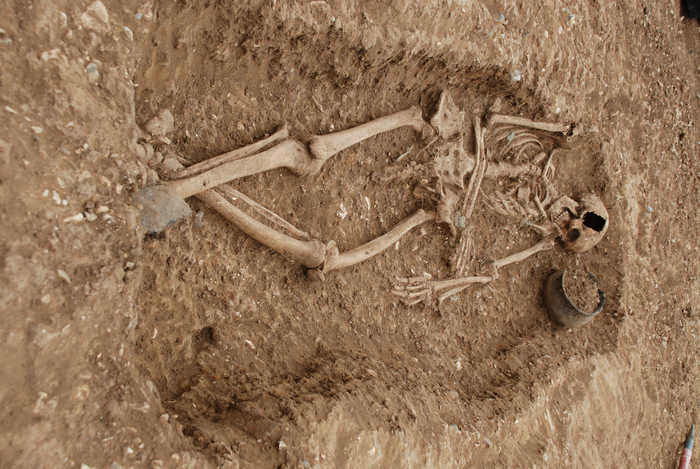
Upon arrival, the migrants intermixed with the local population. In one case, in an Anglo-Saxon cemetery from Buckland near Dover, researchers were able to reconstruct a family tree across at least four generations and identify the point in time when migrants and locals intermarried. This family showed a large degree of interaction between the two gene pools. Overall, the researchers witnessed burials of prominent status across the studied cemeteries of both local and migrant origin.
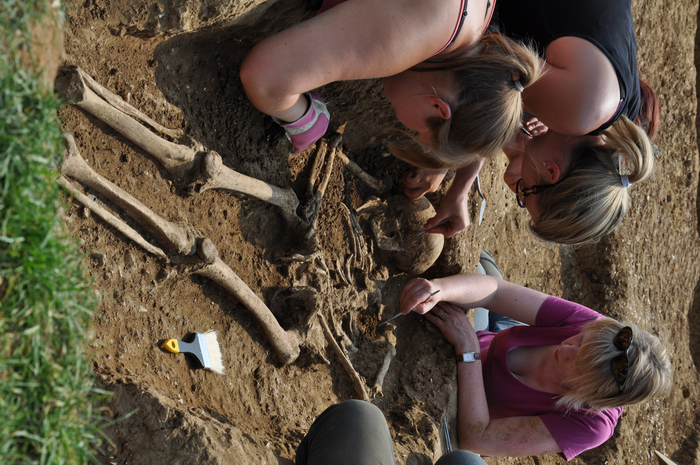
The interdisciplinary team consisting of over 70 authors was able to integrate archaeological data with these new genetic results, which revealed that women of immigrant origin were buried with artifacts more often than women of local origin, especially considering items such as brooches and beads. Interestingly, men with weapons were found to have both genetic origins equally often. These differences were locally mediated with prominent burials or wealthy graves seen across the range of origins. For example, a woman buried with a complete cow in Cambridgeshire was genetically mixed, with majority local ancestry.
Duncan Sayer, archaeologist from the University of Central Lancashire and a lead author of the study says “We see considerable variation in how this migration affected communities. In some places, we see clear signs of active integration between locals and immigrants, as in the case of Buckland near Dover, or Oakington in Cambridgeshire. Yet in other cases, like Apple Down in West Sussex, we see that people with immigrant and local ancestry were buried separately in the cemetery. Perhaps this is evidence of some degree of social separation at this site.”
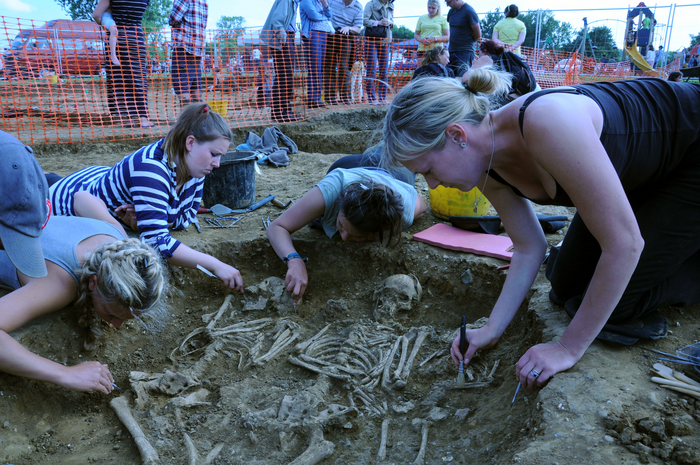
Impact of this historic migration on present-day English people
With the new data, the team could also consider the impact of this historic migration today. Notably the present-day English derive only 40 percent of their DNA from these historic continental ancestors, whereas 20 to 40 percent of their genetic profile likely came from France or Belgium. This genetic component can be seen in the archaeological individuals and in the graves with Frankish objects found in early Medieval graves, particularly in Kent.
“It remains unclear whether this additional ancestry related to Iron Age France is connected to a few punctuated migration events, such as the Norman conquest, or whether it was the result of centuries-long mobility across the English Channel”, says Stephan Schiffels, lead senior author of the study. “Future work, specifically targeting the medieval period and later will reveal the nature of this additional genetic signal.
Joscha Gretzinger et al., The Anglo-Saxon migration and the formation of the Early English gene pool, Nature (21-Sep-2022), DOI: 10.1038/s41586-022-05247-2
Press release from the Max Planck Institute for Evolutionary Anthropology
Genetic and archaeological study, the largest to date of Early Medieval Europe, reveals there was indeed large-scale Continental migration into eastern England during the Early Middle Ages
THE Archaeogenetics Research Group at the University of Huddersfield has played a key role in the largest genetic study to date of Early Medieval Europe.
The study has been conducted by an interdisciplinary team that consisted of more than 70 geneticists and archaeologists, led by the Max Planck Institute for Evolutionary Anthropology in Germany and the University of Central Lancashire, with the help and expertise of the University’s Archaeogenetics Research Group. The team has examined, in detail, one of the largest population transformations in the post-Roman world.
Following their analysis of more than 400 individuals from ancient Britain, Ireland, Germany, Denmark and the Netherlands, the research has shown that there was a large-scale stream of migration from the Continental North Sea region into Eastern England during the Anglo-Saxon period, starting around 1500 years ago.
Almost 500 years after the Romans left, early historians like the Venerable Bede wrote about the Angles and Saxons and their migrations to Britain. But over the last century, views of what happened became polarised amongst historians and archaeologists. Was there really a large-scale migration from the Continent, or was it more of a conquest by a small warrior elite?
The new genetic results now show that three quarters of the Early Medieval population in Eastern England was comprised of migrants whose ancestors originated from Continental regions bordering the North Sea. What is more, as analysis of the maternally inherited mitochondrial DNA by Huddersfield specialist Dr Maria Pala demonstrated, the immigrants were made up as much by women as by men – in other words, whole families were involved.
Migrants intermarried with the local population, but with variation from place to place
These families interbred with the existing population of Britain, but this integration varied enormously from region to region. For example, at West Heslerton, an Anglo-Saxon cemetery in North Yorkshire excavated over several decades by Professor Dominic Powlesland, most ancestry was from the Continent, whereas at the contemporary post-Roman site of Worth Matravers in Dorset, excavated by Bob Kenyon and Lilian Ladle, there was almost none.
However, most of the Anglo-Saxon sites in eastern and southern England fell somewhere in between. Dr Ceiridwen Edwards, who runs the Ancient DNA Facility at Huddersfield, studied the site of Apple Down in Sussex. This cemetery had almost 50 per cent Continental ancestry but, unusually, there were distinct burial styles for people with local and immigrant ancestry, which suggests some level of social separation, at least at this site.
“With 278 ancient genomes from England and hundreds more from Europe, we have now gained really fascinating insights into population-scale and individual histories during post-Roman times,” explains PhD researcher Joscha Gretzinger, who led the study with Dr Stephan Schiffels at the Max Planck Institute and Professor Duncan Sayer at UCLan.
Also, at the same time, the Anglo-Saxons were far from being the only people to shape the ancestry of the English. The team estimated that the present-day English derive only around 40 percent of their DNA from these medieval Continental ancestors.
Director of the Evolutionary Genomics Research Centre, Professor Martin Richards, leads the Archaeogenetics Research Group at the University of Huddersfield and says this research has only been made possible due to a huge advance in ancient DNA sequencing technologies.
“Resolving the question of the English settlements has been a dream of mine since I first started working in archaeogenetics three decades ago,” said Professor Richards. “It has now finally become possible because of the incredible strides in ancient DNA sequencing technologies that have been made in the last few years.”
The work at the University of Huddersfield was funded as part of a Leverhulme Trust Doctoral Scholarship programme awarded to Professor Richards and Dr Maria Pala, and a Leverhulme Trust Project Grant awarded to Dr Ceiridwen Edwards.
- This open access work was published in Nature on 21 September 2022 titled ‘The Anglo-Saxon migration and the formation of the early English gene pool’. Further discussion of this research will be available in a special issue of the Current Archaeology magazine in print on 6 October.
Press release from the University of Huddersfield


